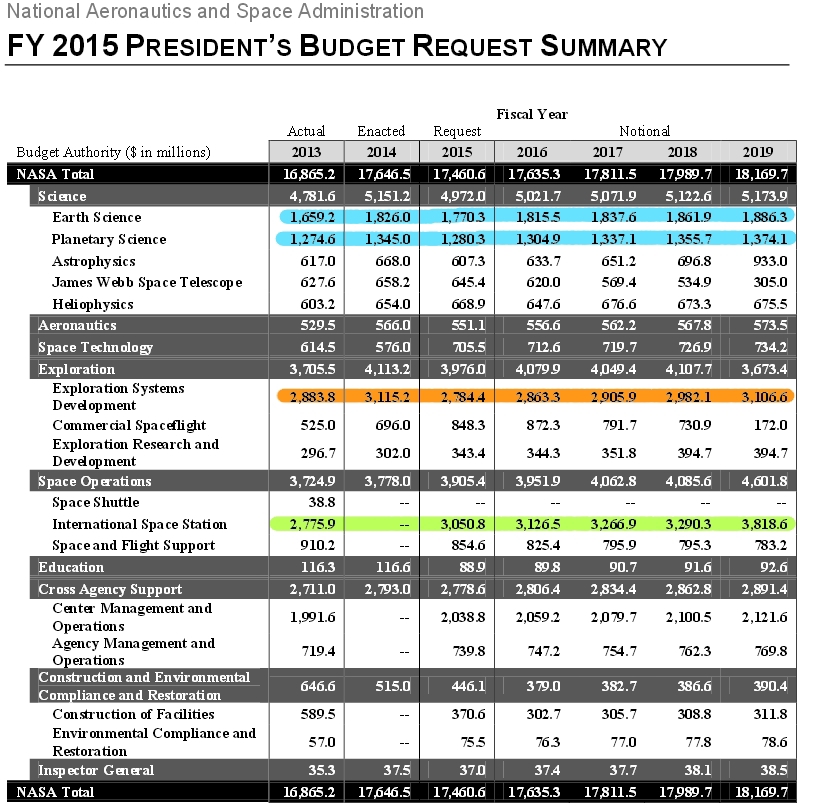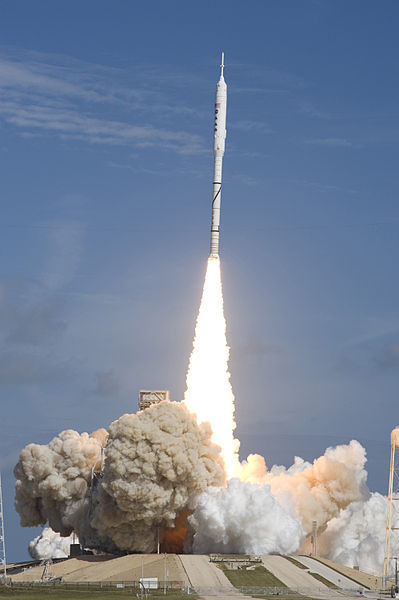What prevents to enjoy the first flight of Orion?

The past week was marked by the successful first test launch of the Orion spacecraft. It would seem that life is beautiful - today an unmanned launch, and on the historical scale of "tomorrow", astronauts will step on Mars. However, not everything is so simple in the run-up for the “big jump”. What does the current situation look like if you try to compare it with the lunar program of the USA and the program “Constellation”?
AS-202 and pace

If you try to compare the mission of Orion EFT-1 with the missions of Apollo, then the closest missions will be AS-201 and AS-202 . In all three cases:
- A lighter booster (Saturn IB and Delta IV Heavy) is used.
- The height of the apocenter does not exceed 10,000 km.
- Entry into the atmosphere does not exceed 9 km / s.
Wikipedia has already written that the EFT-1 mission is similar to Apollo 4 , but I disagree. At Apollo 4, the Saturn V carrier rocket was used, and the entry speed exceeded 11 km / s.
And the differences between EFT-1 and AS-201 and -202 are not in favor of Orion. On test flights, the Apollos were fully equipped - a command module, a service module, and a rescue system. “Orion” flew with a mass-dimensional mockup of the service module, in which there were neither engines, nor fuel, nor solar batteries. In theory, this is not scary - the service module is made on the basis of the developed European ATV cargo ship, but, in any case, checking the service module would be useful, and the engine of the service module could run the command module to a higher speed in order to better simulate atmospheric entry returning from the moon / mars.
Let us now try to estimate the speed of the Apollo and Orion programs. Today, the following Orion missions are known :
- EFT-1, took place on December 5, 2014, unmanned test flight in near-earth orbit.
- EM-1, the dates have already moved from 2017 to the end of 2018, an unmanned test flight to the Moon on an SLS launch vehicle.
- EM-2, 2021, has already become the 2020s, the first manned launch, originally planned for an asteroid, but now its goal is not clear.
- EM-3, 2023, the goal is also unclear, perhaps flying to an asteroid.
- The final goal is Mars, let's call it conditionally “EM-Mars”, the dates are “2030s” .
Such a set of missions does not correspond to the Apollo program directly, but, nevertheless, it is possible to approximate the missions to:
- EFT-1 - AS-201, because this is the first launch of the new ship.
- EM-1 - Apollo-4, because in both cases, a new super-heavy rocket is being tested.
- EM-2 - Apollo-7, because this is the first manned launch (I assumed that the EM-2 would still be an Orion test and not a flight to an asteroid).
- EM-3 or EM-Mars - Apollo 11. EM-3 - this is a very serious stretch, it may be more correct to compare with the "Apollo-10" or even -8, but between the seventh and eighth, as well as the tenth and eleventh "Apollo" Only two months have passed, the difference in the rate of movement of projects will be terrifying.
Let's try to make the following label:
')

A somewhat bleak picture opens. Even if you do not take into account the fact that the development of "Orion" was carried out since 2004 as part of the program "Constellation", and leave the current predictions of the dates, which already for EFT-1 have gone down for a year and a half (the mission was originally scheduled for July 2013 ), it turns out that, if we call the EM-3 a mission comparable to the Apollo 11, then the movement of the Orion project is more or less normal 2.6 times slower. But if to compare with the first landing of a man on the Moon, only the first landing of a man on Mars, then the development is slower in a depressing 6 times. This difference leads to the fact that the quantitative difference turns into a qualitative one - even for the 2020s, the plans are now very vague.
In addition, the more often the technique is used, the better it is known. Combining ship tests with ambitious targets in space is very risky.
Money
The second big sorrow of the Orion program is the financial situation. There is a famous NASA budget schedule:

The graph shows the NASA budget as a percentage of the US budget.
In 2013, the NASA budget put a sad anti-record , dropping below 0.5% of the US budget. Maybe we are waiting for a new rise in financing? Let's take the official document - request of the NASA budget for 2015 . How does the agency itself see its future?


Please note that the structure of expenses according to the plans of the agency will not change. A lot of money is needed by the ISS (green), there are no plans to curtail research programs (blue). And the orange line highlighted in the development of new ships almost all goes to the development of Orion and SLS. Such plans give a hint as to why the mission to the asteroid moved out from 2021 to the 2020s - the “Orion” on the SLS can be maximally sent around the moon in the style of “Apollo 8”. For an asteroid, an “asteroid module” is needed; for the moon, it is lunar, and the money for their development is not even planned. There is, of course, the option that they are “hidden” in already existing graphs, but this is highly unlikely - the sums are needed large.
Separately, an alarming sign should be noted - look at the Education column. The fall in spending on grants and educational projects means that the agency is forced to save.
Outside NASA, the situation also does not look bright. In 1961, when President Kennedy announced a lunar program, the economy and structure of US budget spending looked better than it is now. The economy grew at a fast pace, public debt in percent of GDP fell steadily:

The United States did not have time to be drawn into the Vietnam War (and now they are spending resources on the situation in Iraq and Afghanistan). And I'm not talking about a lot of smaller problems. Under such conditions, the probability that a new Kennedy will appear and announce a significant increase in spending on space is extremely low.
Idea
The economy is a soulless thing. But man is not an absolutely rational being, he can be inspired and persuaded to sacrifice a part of his comfort for a great goal. Listen to President Kennedy’s speech at Rice University in 1962:
The video has been rewound to a climax, but I would recommend watching the video in full and read the Russian translation if you don’t understand English by ear. This is a historical speech that inspired the generation. At the time of the performance, the United States carried out only 4 manned space flights of a total duration of 10 hours, the number of launched satellites was measured in dozens, and the USSR led the space race with a huge margin. And Kennedy talked about flying to the moon! And he said honestly - it will be difficult, it will be expensive, but it can give us huge benefits. Yes, he turned out to be only partially right - the satellites brought great practical benefits, and the benefit of the lunar program can only be measured indirectly through the spread of related technologies. But a breakthrough into space, a civilization turn, became one of the factors that led us to today's world.
But if we return now, the situation will be reversed.
Fall of the "Constellation"

In 2004, the program “Constellation” was launched, the result of which were the Ares I and Ares V launch vehicles, the Orion spacecraft, the return to the Moon no later than 2020, and the ultimate goal is Mars.
In 2009, a successful Ares IX test flight took place, in which the first stage of the Ares I rocket was tested, which is a modification of the Space Shuttle solid propellant accelerator. However, in 2010, the newly elected President Obama accused the constellation program of budget overruns, deadlines, and lack of innovation . Projects of light and heavy "Ares" were closed. President Obama delivered a speech at the. Kennedy:
Now, five years later, we can see what he promised and what was done:
- Increase NASA budget by $ 6 billion over 5 years. Not done.
- The rate on the private space companies (transition from the order of the ships to the order of transport services). Performed.
- Development on the basis of "Orion" rescue ship for the ISS. Not done.
- Development of a new heavy rocket with the end of design no later than 2015. The SLS launch vehicle is being developed .
- Fly into space more often, more and cheaper in the 2020s.
- Manned missions beyond the lunar orbit by 2025. Flight to an asteroid.
- The mission to the orbit of Mars in the mid-2030s and then the mission with the landing.
The ship "Orion" was also included in the program "Constellation", and, as we now know, in 2010 they wanted to make a rescue ship out of it. However, in May 2011, it was announced that the Orion spacecraft would retain its destination as a spacecraft for flights beyond the Earth’s orbit, and instead of the Ares launch vehicle family, an extra heavy SLS launch vehicle will be developed.
The next presidential election in the United States will be held in 2016, and the knowledge of the fate of the program "Constellation" causes fear that today's program may be similarly closed in 2017.
And about technology

I don’t know about you, but the commentator’s phrase during the launch of Orion - “Orion’s Dawn” and the dawn of a new era of American space exploration “jarred me a little”. And the matter is not even in the external similarity of the Orion to the Apollo. The Orion landing system with two brake parachutes, three main and inflatable balloons for turning the hatch up in the water is completely similar to the Apollo. The rescue system is inherited from the Ares I launch vehicle. Solid-fuel rockets explode with the scattering of burning fragments, the rescue system is much more powerful, and therefore it is so much more than the Apollo SED. The service module has a smaller core diameter and drop panels. Yes, on the one hand, they will hide the solar panels under themselves and carry the power load on the withdrawal, but in fact the double wall of the service module still looks irrational. The future SLS rocket uses the same mixture of Space Shuttle developments and the Saturn rocket family as the closed Ares. There are problems with deadlines and budget overruns for any large space program, so if sometime Orion will again want to close for “deadlines, budget breakdown and lack of innovation,” it will be difficult to argue.
Now, after the first test flight of the Orion, and almost five years after the closure of the Constellation, it is even somewhat amusing to read, for example, such reviews :
“We can hardly afford the cost of Apollo on steroids, as the former NASA Administrator called Ares / Orion program” - Elon Musk, head of SpaceX.
P.S
You do not need to be a psychic to predict the obvious ad hominem argument to what I wrote. "You're just jealous of American success and deliberately caught up with dill." In addition to the reminder that the argument to the person - a kind of demagoguery, I will say straight. I love my country and would like my fellow citizens to land on the moon, fly to Mars and beyond. But this does not prevent me from enjoying other people's successes, but, returning to Orion, I would like its future to be more cloudless.
Source: https://habr.com/ru/post/363997/
All Articles